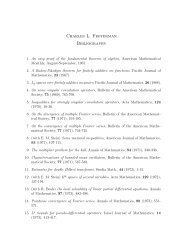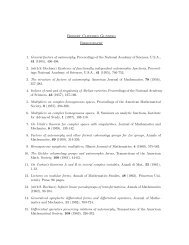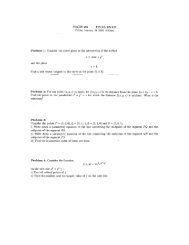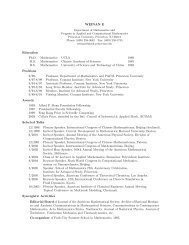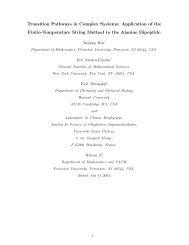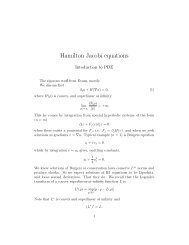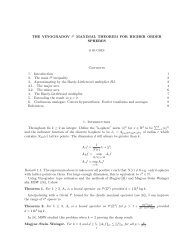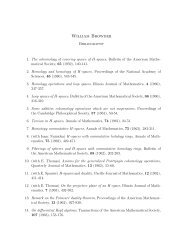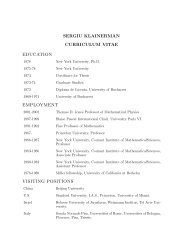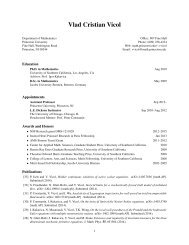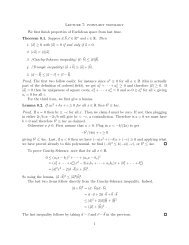The rational Khovanov homology of 3-strand pretzel links
The rational Khovanov homology of 3-strand pretzel links
The rational Khovanov homology of 3-strand pretzel links
You also want an ePaper? Increase the reach of your titles
YUMPU automatically turns print PDFs into web optimized ePapers that Google loves.
16 ANDREW MANION<br />
contradicting our assumption.<br />
□<br />
In particular, if V and W have no exceptional pairs (i.e. E V and E W are identically<br />
zero), then there can be no nontrivial well-structured cancellation <strong>of</strong> V ⊕ W.<br />
One type <strong>of</strong> cancellation which occurs frequently is the following “standard cancellation:”<br />
suppose V and W are contained in the same two adjacent δ-gradings, with<br />
E V (i) > 0 and E W (i+1) > 0. <strong>The</strong>n one can single out two generators each from V and<br />
W in the configuration <strong>of</strong> Figure 7. Cancelling the generators in the middle q-grading<br />
produces a knight’s move, so the resulting space is still well-structured.<br />
Remark 3.7. Below, we will <strong>of</strong>ten see a set <strong>of</strong> cancellations containing several standard<br />
cancellations, and we will want to show no more cancellations can occur. We can argue<br />
as follows: suppose we did some standard cancellations on V ⊕ W to get X, and then<br />
did another cancellation. <strong>The</strong> additional cancellation would, in fact, be a cancellation <strong>of</strong><br />
V ′ ⊕W ′ , a proper subspace <strong>of</strong> X obtained from V ⊕W by removing all four generators at<br />
each standard cancellation (rather than only those in the middle q-grading). <strong>The</strong> reason<br />
is that, after a standard cancellation, the two remaining generators under consideration<br />
are in the wrong δ-gradings to cancel (the generator <strong>of</strong> V is in the lower δ-grading, and<br />
the generator <strong>of</strong> W is in the higher one). Now, the spaces V ′ and W ′ are well-structured<br />
and have fewer exceptional pairs than V and W, so in many cases we will be able to<br />
apply Lemma 3.6 and derive a contradiction.<br />
We can also identify a situation in which we can conclude a standard cancellation<br />
occurred, given some information about X:<br />
Lemma 3.8. Assume V and W are contained in the same two adjacent δ-gradings.<br />
Suppose i is the lowest t-grading <strong>of</strong> W and E W (i) > 0. Assume also that E V (i − 1) ><br />
E X (i − 1). <strong>The</strong>n a standard cancellation must have occurred between t-gradings i − 1<br />
and i.<br />
<strong>The</strong>se two cancel<br />
Q<br />
Q<br />
Q<br />
Q<br />
Q<br />
Q<br />
Figure 7. A standard cancellation. Red generators are from V , blue<br />
generators are from W, and green generators belong to X after the cancellation.




